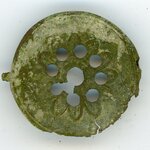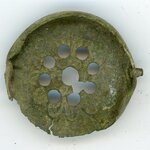Erik in NJ
Silver Member
- Oct 4, 2010
- 4,037
- 3,043
- 🥇 Banner finds
- 1
- Detector(s) used
- Minelab Explorer SE Pro & CTX-3030
- Primary Interest:
- Metal Detecting
Thought It Was the Top to a Salt Shaker But It's Not
It was found on a property that has a house that goes back to 1800 and contained a small factory that manufactured brooms for the Civil War effort--also sold sundries before or after. It's very thin, came up just above the foil range. It's an 1-1/4" in diameter. The holes are too big for a salt shaker top. The stud on the side has a tiny hole through it--for a chain? The rim on the opposite side has three holes about the same size as the holes in the top ring. Notice the center engraving of two concentric rings that looks like it was done by hand and done in error. It's not cast, but stamped metal, very fragile piece. I'm sure someone can ID this piece.
It was found on a property that has a house that goes back to 1800 and contained a small factory that manufactured brooms for the Civil War effort--also sold sundries before or after. It's very thin, came up just above the foil range. It's an 1-1/4" in diameter. The holes are too big for a salt shaker top. The stud on the side has a tiny hole through it--for a chain? The rim on the opposite side has three holes about the same size as the holes in the top ring. Notice the center engraving of two concentric rings that looks like it was done by hand and done in error. It's not cast, but stamped metal, very fragile piece. I'm sure someone can ID this piece.








 Breezie
Breezie